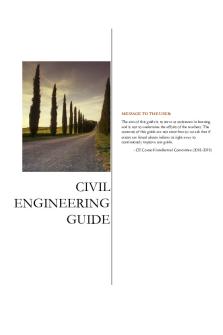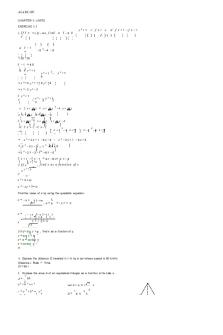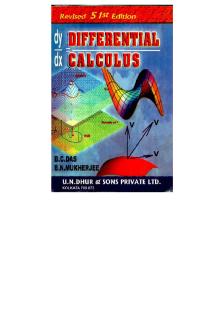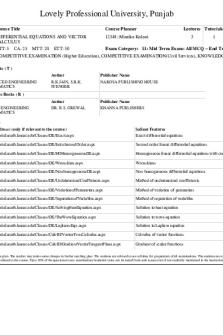Survival-Guide-2 - Tutorial guide for Differential Calculus and Integral Calculus PDF

| Title | Survival-Guide-2 - Tutorial guide for Differential Calculus and Integral Calculus |
|---|---|
| Author | DM Oñate |
| Course | Civil Engineering |
| Institution | University of San Carlos |
| Pages | 56 |
| File Size | 2.3 MB |
| File Type | |
| Total Downloads | 49 |
| Total Views | 137 |
Summary
Tutorial guide for Differential Calculus and Integral Calculus...
Description
MESSAGE TO THE USER: The aim of this guide is to serve as assistance in learning and is not to undermine the efforts of the teachers. The contents of this guide are not error-free so we ask that if errors are found please inform us right away to continuously improve our guide. - CE Council Intellectual Committee (2018-2019)
CIVIL ENGINEERING GUIDE
SOLID MENSURATION
PLANE FIGURES
REGULAR POLYGON
Given: a, b, c
- A regular polygon of n sides can be divided into m congruent isosceles triangles. Area 𝐴 = √𝑠(𝑠 − 𝑎)(𝑠 − 𝑏)(𝑠 − 𝑐) Perimeter 𝑃 =𝑎+𝑏+𝑐
𝑠=
RECTANGLE
where:
𝑛𝑠 2
180° 𝑛
4𝑡𝑎𝑛(
)
SQUARE
where: s=length of 1 side n=number of sides
TRIANGLE -A polygon that has 3 sides and 3 vertices Given: b and h
Area 1 𝐴 = 2 𝑏ℎ Perimeter 𝑃 =𝑎+𝑏+𝑐
Where: B = base H = height
Given: a, b, ϴ
Area 1 𝐴 = 𝑎𝑏 sin 𝜃 2 Perimeter 𝑃 =𝑎+𝑏+𝑐
𝑎+𝑏+𝑐 2
-Is a parallelogram in which the interior angles are all right angles. Diagonal 𝑑 = √𝑏 2 + ℎ2 Perimeter 𝑃 = 2𝑏 + 2ℎ Area 𝐴 = 𝑏ℎ
a = apothem 𝜃 = central angle s = length of side Central Angle 360° 𝜃= ; n = no. of sides 𝑛 Apothem 360° 𝑠 𝜃 = tan = tan 2 𝑛 2𝑎 Solving for a, 𝑠 𝑎= 180° 2 tan ( 𝑛 ) Area 1 where: P=perimeter 𝐴 = 2 𝑃𝑎 a=apothem 𝐴=
Where:
Where: 𝜃 = angle between given sides
-A special type of rectangle in which all sides are equal. Diagonal 𝑑 = 𝑎√2 Perimeter 𝑃 = 4𝑎 Area 𝐴 = 𝑎2
RHOMBUS
-Is a parallelogram in which all sides are equal. Where: h = height b = length of one side
Diagonal
𝑑1 2 = 2𝑏 2 (1 − cos 𝜃) 𝑑2 2 = 2𝑏 2 (1 + cos 𝜃)
𝑃 = 4𝑏 1 If given d1 & d2, 𝐴 = 𝑑1 𝑑2 2 If given b & h, 𝐴 = 𝑏ℎ If given b & ϴ, 𝐴 = 𝑏 2 sin 𝜃 Perimeter
TRAPEZOID -Is a quadrilateral with one pair of parallel sides
Area 1 𝐴 = (𝑏 + 𝑎 )(ℎ) 2 Perimeter 𝑃 =𝑎+𝑏+𝑐+𝑑
CIRCLE
-A circle is a set of points, each of which is equidistant from a fixed point call a center
Area
𝐴 = 𝜋𝑟 2 𝑜𝑟 Perimeter 𝑃 = 2𝜋𝑟 Arc length
𝑠 = 𝑟𝜃
𝜋𝐷 4
Where: 𝜃 = central angle s = arc length
Area 1 𝐴 = 𝑟𝑠 2 Perimeter 𝑃 = 𝑟(2 + 𝜃)
𝑠 = 𝑟𝜃
𝑟=
𝑟=
𝑟=
𝑛𝑠 2
180°
4 tan( 𝑛 )
𝑎𝑏𝑐 4𝑎
𝑎𝑏𝑐
4√𝑠(𝑠−𝑎)(𝑠−𝑏)(𝑠−𝑐)
where: 𝑠 =
𝑎+𝑏+𝑐 2
where: 𝑠 =
𝑎+𝑏+𝑐 2
𝐴 𝑠
𝑟=√
Where: L = chord Segment Area 1 𝐴 = 𝑟 2 (𝜃 − sin 𝜃) 2 Perimeter 𝑃 = 𝑠+𝐿 ;
where: s = length of one side r = radius 𝜃 = central angle (rad)
“Inscribed regular polygon” 𝑠 = 𝑟√𝑥(1 − cos 𝜃) 𝑃 = 𝑛𝑠 𝐴=
2
Sector
Circumscribed & Inscribed Polygons -A polygon is inscribed in a circle if the vertices of the polygon lie on the circle -A polygon is circumscribed about the circle if each side of the polygon is tangent to the circle. Examples:
(𝑠−𝑎)(𝑠−𝑏)(𝑠−𝑐) 𝑠
ELLIPSE -is a conic with an eccentricity that is less than 1 𝐿 = 𝑟 √2(1 − cos 𝜃) 𝐴 = 𝜋𝑎𝑏
𝑃 = 2𝜋√−
where: a = major radius b = minor
𝑎 2 +𝑏 1 2
PARABOLA -is a conic section in which the eccentricity is equal to 1
Area of Parabola = 3 𝑏ℎ 2
Area of Spandrel = 𝑏ℎ 3 𝑃=
1
√𝑏2 +16ℎ2 2
+ 8ℎ ln [ 𝑏2
4ℎ+√𝑏2 +16ℎ2 𝑏
]
PRISMS
Solid FiguresREGULAR PYRAMID
-They can be described as a three dimensional solid formed by dragging a polygon through space to a certain height without rotating or tilting the polygon.
-is a right pyramid whose base is a regular polygon
Where: B = length of one side E = lateral edge Where: h = height e = lateral edge b = length of one side l = slant height B = base area Lateral Surface Area: 𝐿𝑆𝐴 = 𝑃𝑒 Total Surface Area: B is the area of one base 𝑇𝑆𝐴 = 𝐿𝑆𝐴 + 2𝐵 Volume: B is the area of the base; h is the height 𝑉 = 𝐵ℎ
CYCLINDER
-is a solid bounded by a closed cylindrical surface and two parallel planes cutting all the elements of the surface.
Lateral Surface Area: P = perimeter 1 𝐿𝑆𝐴 = 𝑃𝐿 2 Total Surface Area: B = area of the base 𝑇𝑆𝐴 = 𝐵 = 𝐿𝑆𝐴 Volume: 1 𝑉 = 𝑏ℎ 3
CONE
-is the solid formed by one nappe of a closed surface and a plane cutting all the elements of the line Where: l = slant height h = height r = radius
Lateral Surface Area: 𝐿𝑆𝐴 = 2𝜋𝑟ℎ Total Surface Area: 𝑇𝑆𝐴 = 2𝜋(𝑟 + ℎ) Volume: 𝑉 = 𝐵ℎ = 𝜋𝑟 2 ℎ
Lateral Surface Area 𝐿𝑆𝐴 = 𝜋𝑟𝑙 Total Surface Area 𝑇𝑆𝐴 = 𝜋𝑟(𝑟 + 𝑙 ) Volume 1 𝑉 = (𝜋𝑟 2 ℎ) 3
FRUSTUM OF A RIGHT CIRCULAR CONE
PRISMATOID
-is a portion of the cone enclosed by its base, a section that is parallel to the base and the conical surface included between the base of the cone and the parallel section.
-is a polyhedron where vertices all lie in two parallel planes.
Where: l = slant height h = height r1= radius of the upper base r2= radius of the lower base
𝑙 = √ℎ2 + (𝑟2 + 𝑟1 )2 Later Surface Area: C is the circumference 𝐿𝑆𝐴 = 𝜋 (𝑟1 + 𝑟2 )𝑙 Total Surface Area 𝑇𝑆𝐴 = 𝜋(𝑟1 + 𝑟2 )𝑙 + 𝜋𝑟12 + 𝜋𝑟22 Volume: 𝜋ℎ(𝑟12 + 𝑟22 + 𝑟1 𝑟2 ) 𝑉= 3
FRUSTUM OF A REGULAR PYRAMID
-it is a polyhedron enclosed by the lateral surface, the base of the pyramid and the section of the pyramid
Volume: B1, B2, M are all areas 1 𝑣 = ℎ(𝐵1 + 𝐵2 + 4𝑀) 6
-
SPHERE -a sphere is a three-dimensional solid bounded by a surface consisting of all points equidistant from an interior point called the center. Where: O = center R = Radius Surface Area 𝑆 = 4𝜋𝑅 2 Volume 4 𝑉 = 𝜋𝑟 2 3
INSCRIBED SOLIDS
-is a solid of maximum volume placed inside another solid of fixed volume, with their edges of surfaces touching each other. “A cylinder inscribed in a sphere”
Where: e = lateral edge l = slant height h = height Lateral Surface Area: P is the perimeter 1 𝐿𝑆𝐴 = (𝑃1 + 𝑃2 )𝑙 2 Total Surface Area: B1 & B2 are the areas 𝑆𝐴 = 𝐿𝑆𝐴 + 𝐵1 + 𝐵2 Volume: ℎ(𝐵1 + 𝐵2 √𝐵1 𝐵2 ) 𝑣= 3
Analysis: D = diameter of sphere 2r = diameter of cylinder h = height of cylinder 𝐷 = √(2𝑟)2 + ℎ2
“A sphere inscribed in a cube”
Analysis: D = is the diameter of the sphere S = length of an edge of the cube
PAPPUS-GULDINUS THEOREMS Theorem 1: The surface of the revolution is defined as the surface generated by rotating a plane curve through 360° about an axis 𝑠 = 2𝜋 ∑ 𝐿𝑑 Where: L = length of an element d = centroidal distance from axis of revolution Example
Theorem 2: The solid of revolution is the solid formed by rotating a plane through 360° about an axis 𝑉 = 2𝜋 ∑ 𝐴𝑑
Where: D = centroidal distance form axis of revolution A = area of the plane Example
DIFFERENTIAL CALCULUS
LIMITS AND CONTINUITY •
DEFINITION -Let f be a function defined at every number in some open interval containing a, except possibly at the number a itself. The limit of f(x) as x approaches a is L, written as: lim 𝑓(𝑥) = 𝐿 if the following statement is true: 𝑥→𝑎
Given any ∈> 0, however small, there exists a 𝛿 > 0 such that if 0 < |𝑥 − 𝑎| < 𝛿 then |𝑓(𝑥) − 𝐿| 0 we know that xr stays in the denominator. As we increase x, xr will also increase. So we will have a constant divided by an increasingly large number and so the result will also be increasingly small. b. If r is a positive rational number, c is any real number and xr is defined for x 0 and if 𝑓(𝑥) → 0 through positive values of 𝑓(𝑥), 𝑔(𝑥) = +∞ lim 𝑥→𝑎 𝑓(𝑥) If 𝑐 > 0 and if 𝑓(𝑥) → 0 through negative values of 𝑓(𝑥), 𝑔(𝑥) = −∞ lim 𝑥→𝑎 𝑓(𝑥)
If 𝑐 < 0 and if 𝑓(𝑥) → 0 through positive values of 𝑓(𝑥), 𝑔(𝑥) = −∞ lim 𝑥→𝑎 𝑓(𝑥) (iv) If 𝑐 < 0 and if 𝑓(𝑥) → 0 through negative values of 𝑓(𝑥), 𝑔(𝑥) lim = +∞ 𝑥→𝑎 𝑓(𝑥) NOTE: The theorem will remain valid if 𝑥 → 𝑎 is replaced by 𝑥 → 𝑎 + 𝑜𝑟 𝑥 → 𝑎 − c. SUMS INVOLVING INFINITE LIMITS (i) If lim 𝑓(𝑥) = +∞, and lim 𝑔(𝑥) = 𝑐, (iii)
𝑥→𝑎
𝑥→𝑎
where c is any constant, then
lim [𝑓(𝑥) + 𝑔(𝑥)] = +∞ (ii) If𝑥→𝑎 lim 𝑓(𝑥) = −∞, and lim 𝑔(𝑥) = 𝑐, where c is any constant, then 𝑥→𝑎
𝑥→𝑎
lim[𝑓( 𝑥) + 𝑔(𝑥)] = −∞
𝑥→𝑎
NOTE: The theorem will remain valid if 𝑥 → 𝑎 is replaced by 𝑥 → 𝑎 + 𝑜𝑟 𝑥 → 𝑎 −
d. PRODUCTS INVOLVING INFINITE LIMITS If lim 𝑓(𝑥) = +∞, and lim 𝑔(𝑥) = 𝑐, 𝑥→𝑎
𝑥→𝑎
where c is any constant except 0, then (i) If 𝑐 > 0, lim[𝑓(𝑥)●𝑔(𝑥)] = +∞ (ii)
𝑥→𝑎
If 𝑐 < 0, lim[𝑓(𝑥)●𝑔(𝑥)] = −∞ 𝑥→𝑎
NOTE: The theorem will remain valid if 𝑥 → 𝑎 is replaced by 𝑥 → 𝑎 + 𝑜𝑟 𝑥 → 𝑎 − e. If lim 𝑓(𝑥) = −∞, and lim 𝑔(𝑥) = 𝑐, 𝑥→𝑎
𝑥→𝑎
where c is any constant except 0, then (i) If 𝑐 > 0, lim [𝑓(𝑥)●𝑔(𝑥)] = −∞
(ii)
f.
𝑥→𝑎
NOTE: The theorem will remain valid if 𝑥 → 𝑎 is replaced by 𝑥 → 𝑎 + 𝑜𝑟 𝑥 → 𝑎 − DEFINITION OF A VERTICAL ASYMPTOTE The line 𝑥 = 𝑎 is a vertical asymptote of the function f if at least one of the following statements is true. (i) (ii) (iii) (iv)
•
𝑥→𝑎
If 𝑐 < 0, lim[𝑓(𝑥)●𝑔(𝑥)] = +∞
lim+ 𝑓(𝑥) = +∞
𝑥→𝑎
lim 𝑓(𝑥) = −∞
𝑥→𝑎+
lim 𝑓(𝑥) = +∞ lim− 𝑓(𝑥) = −∞
𝑥→𝑎− 𝑥→𝑎
CONTINUITY A function is said to be continuous at 𝑥 = 𝑎 if there is no interruption in the graph of f (x) at a. Its graph is unbroken at a, and there is no hole, jump, or gap. a. CONTINUITY AT A POINT
A function is said to be continuous at 𝑥 = 𝑎 if
the following three conditions are satisfied:
(i) (ii) (iii)
𝑓(𝑥) is defined, that is, it exists at 𝑥=𝑎 lim 𝑓(𝑥) exists lim 𝑓(𝑥) = 𝑓(𝑎) 𝑥→𝑎
𝑥→𝑎
If one or more of these conditions are not satisfied, we say that the function is discontinuous at 𝑥 = 𝑎.
NOTE: this will still hold true if lim 𝑓(𝑥) is 𝑥→𝑎 replaced by lim+ 𝑓(𝑥) or lim− 𝑓(𝑥) = 𝑏. 𝑥→𝑎
𝑥→𝑎
CONTINUITY ON AN OPEN INTERVAL A function is said to be continuous on an open interval (c, d) if it is continuous at each point I that interval.
CONTINUITY ON A CLOSED INTERVAL A function is said to be continuous on an open interval [a,b] if and only if it is continuous on the open interval (a,b), as well as continuous from the right of a and from the left of b. CONTINUITY FUNCTION
OF
A
COMPOSITE
a. LIMIT OF A COMPOSITE FUNCTION -if lim 𝑔(𝑥) = 𝑏 and if the function f is 𝑥→𝑎
lim (𝑓 ◦ 𝑔)(𝑥) = 𝑥→𝑎
𝑓(𝑏), or, equivalently, lim 𝑓(𝑔(𝑥)) = continuous at b,
𝑓(lim 𝑔(𝑥)) 𝑥→𝑎
𝑥→𝑎
b. If the function g is continuous at a and the function f is continuous at g(a), then the composite function 𝑓 ◦ 𝑔 is continuous at a. REMOVABLE DISCONTINUITY A function is said to have a removable discontinuity at 𝑥 = 𝑎, if (i)
(ii)
lim 𝑓(𝑥)exists, and
𝑥→𝑎
lim 𝑓(𝑥) ≠ 𝑓(𝑎)
𝑥→𝑎
JUMP DISCONTINUITY A function is said to have a jump discontinuity at 𝑥 = 𝑎, if lim− 𝑓(𝑥) ≠ 𝑥→𝑎
lim+ 𝑓(𝑥) for a any positive integer.
𝑥→𝑎
b. THEOREMS
1. If f and g are two functions continuous at the number a, then i. 𝑓 + 𝑔 is continuous at a
ii. 𝑓 − 𝑔 is continuous at a
iii. 𝑓 ● 𝑔 is continuous at a
iv. 𝑓 / 𝑔 is continuous at a, provided that 𝑔 (𝑎) ≠ 0
2. A polynomial function is continuous at every number
3. A rational function is continuous at every
𝑛 4. If n is a positive integer and 𝑓(𝑥) = √ 𝑥,
number in its domain. then
•
(i)
If n is odd f is continuous at every number
(ii)
If n is even, f is continuous at every positive number
LIMITS OF TRANSCENDENTAL FUNCTIONS a. EXPONENTIAL FUNCTIONS 1. LIMIT of 𝑦 = 𝑎 > 1 is (i) lim+ 𝑎 𝑥 = 1 (ii)
𝑥→0
lim 𝑎 𝑥 = 1
𝑥→0−
lim 𝑎 = +∞
(iv)
𝑥→+∞
(ii)
𝑥→0
(iii)
𝑎𝑥 , 𝑥
lim 𝑎 𝑥 = 0
𝑥→−∞
2. LIMIT of 𝑦 = 𝑎 𝑥 , 0 < 𝑎 < 1 is (i) lim+ 𝑎 𝑥 = 1 (iii) (iv)
lim 𝑎 𝑥 = 1
𝑥→0−
lim 𝑎 𝑥 = 0
𝑥→+∞
lim 𝑎 𝑥 = +∞
𝑥→−∞
3. LIMIT of 𝑦 = 𝑒 𝑥 is (i) lim+ 𝑒 𝑥 = 1 (ii)
(iii) (iv)
𝑥→0
lim− 𝑒 𝑥 = 1
𝑥→0
lim 𝑒 𝑥 = +∞
𝑥→+∞
lim 𝑒 𝑥 = 0
𝑥→−∞
4. LIMIT of 𝑦 = 𝑒 −𝑥 is (i) lim 𝑒 −𝑥 = 1 𝑥→0 (ii) lim+ 𝑒 −𝑥 = 1 − 𝑥→0 (iii) lim 𝑒 −𝑥 = 0 (iv)
𝑥→+∞ −𝑥 lim 𝑒 𝑥→−∞
= +∞
b. LOGARITHMIC FUNCTIONS LIMIT OF 𝑦 = 𝑙𝑛𝑥 (i) lim 𝑙𝑛𝑥 = −∞ 𝑥→0+
(ii) lim 𝑙𝑛𝑥 = +∞ 𝑥→+∞
c. TRIGONOMETRIC FUNCTIONS (i) lim sin 𝜃 = 0 (ii)
(iii) (iv)
𝜃→0
lim cos 𝜃 = 1
𝜃→0
lim
𝜃→0
lim
𝜃→0
1−cos 𝜃 𝜃
sin 𝜃
𝜃
=0
=1
d. HYPERBOLIC FUNCTIONS 1. HYPERBOLIC SINE (i) lim+ sinh 𝑥 = 0 (ii)
(iii) (iv)
𝑥→0
lim sinh 𝑥 = 0
𝑥→0−
lim sinh 𝑥 = +∞
𝑥→+∞
lim sinh 𝑥 = −∞
𝑥→−∞
2. HYPERBOLIC COSINE (i) lim+ cosh 𝑥 = 1 (ii)
(iii) (iv)
𝑥→0
lim cosh 𝑥 = 1
𝑥→0−
lim cosh 𝑥 = +∞
𝑥→+∞
lim cosh 𝑥 = +∞
𝑥→−∞
3. HYPERBOLIC TANGENT (i) lim+ tanh 𝑥 = 0 (ii)
(iii) (iv)
𝑥→0
lim tanh 𝑥 = 0
𝑥→0−
lim tanh 𝑥 = 1
𝑥→+∞
lim tanh 𝑥 = −1
𝑥→−∞
A. Derivatives of A Function 𝑑𝑦 ) − 𝑓(𝑥1 ) ) 𝑚 = 𝑓 ′ (𝑥) = 𝑑𝑥 = lim 𝑓(𝑥1 + ∆𝑥∆𝑥 ( ∆𝑥→0 B. Basic Derivation Formulas
1. 2.
dx
2. Addition: d [ f ( x) + g ( x )] = d f ( x) + d g (x ) dx dx dx
3.
3. Subtraction:
4.
d d d [ f ( x ) − g ( x )] = f ( x ) − g (x ) dx dx dx
5.
4. Function with A Constant: d d [c f (x )] = c f ( x) dx dx
6.
d x e = ex dx
6. Natural Logarithmic Rule:
d ln x = 1 dx x
8. Product Rule: d f (x ) g ( x ) = f ( x ) g ( x) + g ( x) f ( x) dx
3.
1. 2. 3. 4. 5.
𝑑 (𝑢𝑣) = 𝑑𝑥 𝑑(𝑢𝑣𝑤) 𝑑𝑥
𝑢
𝑑( ) 𝑣 𝑑𝑥
𝑑𝑢 𝑛 𝑑𝑥
𝑑√𝑢 𝑑𝑥
=
𝑢
𝑑𝑉
𝑑𝑥
= 𝑢𝑣 𝑑𝑢
𝑑𝑊 𝑑𝑥
𝑑𝑉
𝑉 𝑑𝑥−𝑈 𝑑𝑥 𝑉2
= 𝑛𝑢𝑛−1 =
+𝑉
𝑑𝑢/𝑑𝑥 2√𝑢
𝑑𝑢
𝑑𝑥
𝑑𝑈 𝑑𝑥
+ 𝑢𝑤
𝑑𝑉
𝑑𝑥
+ 𝑣𝑤
𝑑𝑈 𝑑𝑥
𝑑(𝑡𝑎𝑛 𝑢) 𝑑𝑥
𝑑(𝑐𝑜𝑡 𝑢) 𝑑𝑥
𝑑(𝑠𝑒𝑐 𝑢) 𝑑𝑥
𝑑𝑢 𝑑𝑥
= − sin 𝑢
𝑑𝑢
= − sec2 𝑢
= − csc2 𝑢
𝑑𝑥
𝑑𝑢
𝑑𝑥
𝑑𝑢
𝑑𝑥
= − sec 𝑢 tan 𝑢
𝑑(𝑐𝑠𝑐 𝑢) = 𝑑𝑥
𝑑(𝑎𝑟𝑐 cos 𝑢) 𝑑𝑥
𝑑(𝑎𝑟𝑐 tan 𝑢) 𝑑𝑥
𝑑(𝑎𝑟𝑐 cot 𝑢) 𝑑𝑥
𝑑(𝑎𝑟𝑐 sec 𝑢) 𝑑𝑥
𝑑(𝑎𝑟𝑐 csc 𝑢) 𝑑𝑥
6.
C. Derivatives of Algebraic Functions
𝑑𝑥
𝑑𝑥
4. 5.
d f ( g ( x) = f ( g ( x)) g ( x) dx
= cos 𝑢
𝑑𝑥 𝑑(𝐶𝑜𝑠 𝑢)
𝑑(𝑎𝑟𝑐 sin 𝑢)
1. 2.
10. Chain rule:
𝑑(𝑆𝑖𝑛 𝑢)
𝑑𝑥
− csc 𝑢 cot 𝑢
𝑑𝑢
𝑑𝑥
𝑑𝑢
𝑑𝑥
E. Derivatives of Inverse Trigonometric Functions
7. Logarithmic Rule: d loga x = 1 x ln(a ) dx
9. Quotient Rule: d f ( x) g( x) f ( x) − f ( x) g ( x) = dx g( x) g (x )2
𝑑𝑥 𝑑𝑢2 𝑉
𝑢
= D. Derivatives of Trigonometric Functions 6.
1. Constant Function: d (c ) = 0
5. Natural Exponential Rule:
𝑑( 𝑣 )
𝑑𝑢 𝑑𝑥
=
√1−𝑢2 𝑑𝑢 𝑑𝑥
−
=
√1−𝑢2 𝑑𝑢 𝑑𝑥
=
1+𝑢2
=− =
=−
𝑑𝑢 𝑑𝑥
1+𝑢2
𝑑𝑢 𝑑𝑥 𝑢√𝑢2 −1
𝑑𝑢/𝑑𝑥
𝑢√𝑢 2 −1
F. Derivatives of Logarithmic Functions 1. 2. 3.
𝑑(log𝑎 𝑢) 𝑑𝑥
𝑑(ln 𝑢) 𝑑𝑥
=
𝑑(log10 𝑢) 𝑑𝑥
= log 𝑎 𝑒 𝑑𝑢 𝑑𝑥
𝑢
𝑑𝑢 𝑑𝑥
𝑢
= log10 𝑒
𝑑𝑢/𝑑𝑥 𝑢
NOTE: 𝑙𝑜𝑔10 𝑒 = 0.43429
G. Derivatives of Exponential Functions 1. 2.
𝑑(𝑎 𝑢 ) 𝑑𝑥
𝑑(𝑒 𝑢 ) 𝑑𝑥
= 𝑎 𝑢 ln 𝑎
= 𝑒𝑢
𝑑𝑢 𝑑𝑥
𝑑𝑢
𝑑𝑥
3. 4.
𝑑(𝑢𝑣 )
= 𝑣𝑢𝑣−1
𝑑𝑥 𝑎 𝑢) 𝑑(log 𝑑𝑥
=
+𝑢𝑣 ln 𝑢
𝑑𝑢
𝑑𝑥 𝑑𝑥 log𝑎 𝑒 𝑑𝑢 𝑢
𝑑𝑥 𝑑𝑣
H. Derivatives of Hyperbolic Functions 1. 2. 3. 4. 5. 6.
= cos ℎ 𝑢
𝑑(𝑠𝑖𝑛 ℎ 𝑢) 𝑑𝑥
= sin 𝑢
𝑑(cos ℎ 𝑢) 𝑑𝑥
𝑑𝑥
𝑑𝑥
𝑑𝑥
𝑑𝑢
𝑑𝑥
= − csc ℎ2 𝑢
𝑑(cot ℎ 𝑢)
𝑑(csc ℎ 𝑢)
𝑑𝑥
𝑑𝑥
= sec ℎ 2 𝑢
𝑑(tan ℎ 𝑢)
𝑑(sec ℎ 𝑢) 𝑑𝑥
𝑑𝑢
𝑑𝑢
𝑑𝑢
𝑑𝑥
= −sec ℎ 𝑢 tan ℎ 𝑢
= −csc ℎ 𝑢 cot ℎ 𝑢
𝑑𝑢
𝑑𝑥
𝑑𝑢
𝑑𝑥
I. Derivatives of Inverse Hyperbolic Functions 1. 2. 3. 4. 5. 6. 7.
𝑑𝑥
=
𝑑(tan ℎ −1 𝑢) 𝑑𝑥
=
𝑑(sec ℎ −1 𝑢)
=
𝑑(sin ℎ −1 𝑢)
𝑑(cos ℎ−1 𝑢) 𝑑𝑥
𝑑(cot ℎ −1 𝑢) 𝑑𝑥
𝑑𝑥
𝑑(csc ℎ−1 𝑢) 𝑑𝑥
𝑑(𝑔 𝑑𝑢) 𝑑𝑥
= =
=
𝑑𝑢 𝑑𝑥
∙ sin ℎ−1 𝑢
√1+𝑢2
𝑑𝑢 𝑑𝑥 √𝑢2 −1 𝑑𝑢 𝑑𝑥
1+𝑢2 𝑑𝑢 𝑑𝑥
1−𝑢2 𝑑𝑢 𝑑𝑥
∙ cos ℎ −1 𝑢
∙ tan ℎ −1 𝑢 ∙ cot ℎ −1 u
𝑢√1−𝑢 2 𝑑𝑢 𝑑𝑥
𝑢√1+𝑢2
= sec ℎ 𝑢 𝑑𝑥 𝑑𝑢
∙ sec ℎ−1 𝑢
∙ csc ℎ−1 𝑢
Sample Problems & Solutions
4) The kinetic energy of K of a body of mass m and velocity v is given by
EASY 1) Given the √𝑥𝑦 = 𝑥 + 𝑦, where y is an implicit function of x, solve for y’
Solution: √𝑥𝑦 = 𝑦 + 𝑥
1 1 (𝑥𝑦)−2 (𝑥𝑦′ + 𝑦) = 𝑦′ + 1 2
𝑥𝑦′ + 𝑦 2√𝑥𝑦
𝐾 = 𝑚𝑣 2 2 1
(a) Solve for
Solution: 𝐾 = 2 𝑚𝑣 2 ; 1
2) If 𝑦 = 2 (2𝑥 2 + 𝑥) 1
2√𝑥𝑦 − 𝑦
, find
Solutions: 𝑦 = 2 (2𝑥 2 + 𝑥)−3 ; 1
𝑑𝑦
𝑑𝑥
3 = − (2𝑥 2 + 𝑥)−4 (4𝑥 + 1) 2 3 4𝑥 + 1 𝑑𝑦 =− [ ] 𝑑𝑥 2 (2𝑥 2 + 𝑥) 4
Solutions: 𝑦 = 3𝑥 2 − 2𝑥 + 6
𝑑𝑦 = (6𝑥 − 2)𝑑𝑥
𝑤ℎ𝑒𝑟𝑒 𝑑𝑥 = 2.03 − 2 = 0.03 ; 𝑥 = 2 𝑑𝑦 = [6(2) − 2](0.03) 𝑑𝑦 = 0.3
𝜕𝑣 2
=𝐾
1 2 𝑣 ⋅𝑚=𝑘 2 1 𝑚𝑣 2 = 𝑘 2
5) Find the slope of the tangent to the curv...
Similar Free PDFs

Calculus and CAS Tutorial
- 135 Pages
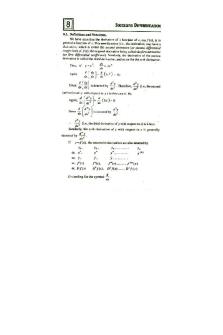
Differential Calculus (Das & Mukherjee)
- 224 Pages

Calculus guide for dummies
- 1 Pages
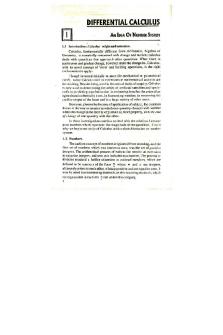
Differential Calculus (Das & Mukherjee)
- 245 Pages

Integral Calculus Sample Problems
- 33 Pages
Popular Institutions
- Tinajero National High School - Annex
- Politeknik Caltex Riau
- Yokohama City University
- SGT University
- University of Al-Qadisiyah
- Divine Word College of Vigan
- Techniek College Rotterdam
- Universidade de Santiago
- Universiti Teknologi MARA Cawangan Johor Kampus Pasir Gudang
- Poltekkes Kemenkes Yogyakarta
- Baguio City National High School
- Colegio san marcos
- preparatoria uno
- Centro de Bachillerato Tecnológico Industrial y de Servicios No. 107
- Dalian Maritime University
- Quang Trung Secondary School
- Colegio Tecnológico en Informática
- Corporación Regional de Educación Superior
- Grupo CEDVA
- Dar Al Uloom University
- Centro de Estudios Preuniversitarios de la Universidad Nacional de Ingeniería
- 上智大学
- Aakash International School, Nuna Majara
- San Felipe Neri Catholic School
- Kang Chiao International School - New Taipei City
- Misamis Occidental National High School
- Institución Educativa Escuela Normal Juan Ladrilleros
- Kolehiyo ng Pantukan
- Batanes State College
- Instituto Continental
- Sekolah Menengah Kejuruan Kesehatan Kaltara (Tarakan)
- Colegio de La Inmaculada Concepcion - Cebu
